咨询方法与工具资料库_prop302【精品文档】
咨询方法与工具资料库concept【精品文档】
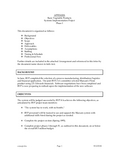
APPENDIXBasic Vegetable ProductsSystems Implementation ProjectPhase IThis document is organized as follows:BackgroundObjectivesScopeApproachDeliverablesAssumptionsStaffingTiming & ScheduleProfessional FeesFurther details are included in the attached Arrangement and referenced in this letter by the document name shown in italic text.In June, BVP completed the selection of a process manufacturing, distribution/logistics and financial application. The joint BVP/AA committee selected Marcam's Prism product using J.D. Edwards financials. Software negotiations have been completed and BVP is now preparing to embark upon the implementation of the new software.The system will be judged successful by BVP if it achieves the following objectives, as articulated by BVP project team members:"The system has to work, with no bombs."BVP personnel will be trained to use and support the Marcam system with additional skills hired during the project as needed.Complete the project on time (Spring 1995).Complete project phases I through IV, as outlined in this document, on or below the overall $5.5 million budget.The scope of the Phase I of the Prism/JDE System Implementation project Prism Business Process Simulation will include:Designing and piloting the following functions:♦Inventory Control♦Warehouse Management and Radio Frequency♦Quality Management♦Purchasing (Maintenance and Raw Material goods are not in scope)♦Bar Coding♦Customer Order Management♦EDI for Customer Order Receipt and Order Acknowledgments♦Standard Costing for Finished Goods and Cost of Goods Sold♦Accounts Payable♦Accounts Receivable♦General LedgerMarcam's PRISM software product will be used as the core manufacturing and logistics system and J.D. Edwards modules will serve as the core financialmodules. The actual modules being piloted include:Marcam Prism♦Foundation♦Resource Management (For packaging and finished goods)♦Resource Processor (Packaging only)♦Purchasing♦Customer Order Management♦Quality Management including Sublotting (a.k.a. Gilroy) modification♦Warehouse ManagementJ.D. Edwards (supported by Marcam)♦Accounts Payable♦Accounts Receivable♦General LedgerPremenos (Not purchased yet by BVP)♦EDIPer BVP, process re-engineering that is necessary and obvious in order to implement the software.The Business Process Simulation will also include the testing of bar-coding equipment and radio frequency technology interfacing to Prism's Warehouseand Resource Management modules.Functional specifications for modifications and interfaces to the new systems required for Phase II implementation will be completed.Recommendations for performance measurements relevant to BVP's key post implementation operations.The AA role has been defined using the base case scenario with a structure of "coach", initially, moving towards "advisor" (rather than "driver" or "team").These terms are designed in the Phase I arrangement document attached to thecontract. The AA effort has been defined by BVP project management. AAexpects to serve in a thorough , complete and active role in this project, and iscommitted to the Basic Vegetable project's success. Due to the structure of ourrole as "coach", moving to "advisor", however, overall decisions and projectresponsibility rest with Basic Vegetable.The following is the overall phasing for the full implementation of the new software.Phase I Business Process SimulationOrder Fulfillment and Procurement ProcessesPhase II Implementation of Phase I ModulesPhase IIA Modesto ImplementationPhase IIB King City ImplementationPhase III Business Process SimulationProduction Analysis, Forecasting and CostingPhase IV Implementation of Phase III ModulesThe modules included in each phase are diagrammed in the attached Project Scope document. The focus of this arrangement is on Phase I of this process. The arrangements for the remaining phases will be finalized at a later date.In order to minimize implementation time and potential disruptions to production and customer service, we will follow the Business Process Simulation and Conference Room Pilot approach depicted below.。
咨询方法与工具资料库FDBCKLOG【精品文档】

Please complete the following information at the end of your Competency Center/Technology session. Competency Center/Technology Team: LogisticsCompetency Center/Technology Leader(s): Pat Dolan, Jim KentWhere are the biggest challenges the integrated competency/technology teams face?Acquiring competent staff quickly and the funding to accomplish thisDeveloping a set of workable performance measurement standards for regional/national practiceWhat integrated competency/technology teams provide the greatest opportunity for BC?Logistics/information technologyHow can we operate as a global team and how can we have a strategy with global influence?Develop worldwide geo-regional competency centers and collaborate among themHow do we encourage or support specialization in smaller practices which may lack the critical mass to do so?A regional practice not permanently attached to specific officesHow do we integrate with other parts of AA - such as ABA, EFC and T&L and how do we leverage that knowledge?We intend to develop relationships with specific audit/industry practicesHow can we better serve AA Worldwide, not just BC?Work with those parts of the org anization that give us the best integrated solution to the client’s needsWhat is missing (e.g. skills, infrastructure) for us to render services to our clients?。
咨询方法与工具资料库pwprop【精品文档】

TABLE OF CONTENTSOUR UNDERSTANDING OF YOUR NEEDS (2)PROJECT SCOPE AND APPROACH (3)PROJECT ASSUMPTIONS (8)QUALIFICATIONS (10)PROJECT TEAM AND FEES (15)Our Understanding of Your NeedsBased on our meeting and subsequent telephone conversations, ourunderstanding of your current environment is as follows:❑People, headquartered in New York, has additional fieldlocations in Chicago, Houston, Los Angeles, Washington D.C.,and London.❑The New York headquarters has approximately 200 personnel.The largest field location is Los Angeles with approximately12-18 personnel. All other satellite offices have staff levelsranging from 2-12 personnel. Freelance writers andphotographers are also utilized on an as needed basis.❑People is currently in the early phases of their InformationSystems Plan. One of the projects currently in progressincludes an in-depth software analysis and selection project.The technology staff is currently comparing Quark’s QPSoffering with Seitex’s P.Ink offering. The final selection willreplace People’s current ATEX software.❑ATEX was historically People’s core business sytem. It wasutilized for story editing as well as the layout of the magazine.In addition, ATEX provided People with a vehicle formessaging and communications.❑As part of People’s Information Systems Plan, the division hascommitted to the use of Lotus Notes.Project Scope and ApproachBased on our discussions and our experience with systems designand implementation, we recommend a phased approach as follows:Phase I:Design and Develop Pilot Application(s)Phase II:Implement Pilot Application(s)Phase III: Develop and Implement AdditionalFunctionality/ApplicationsPhase IV: Design Enterprise-wide InfrastructurePhase V:Implement Enterprise-wide InfrastructurePhase VI: Monitor and Enhance Existing Applications / Identifyand Develop Additional applicationsThe diagram below graphically depicts the various phases of theoverall project with some phases occurring simultaneously.TIME LINE。
第二篇咨询工具与方法

PPT文档演模板
第二篇咨询工具Байду номын сангаас方法
•三、分析问题的工具(1):PDCA法循环
•问题解决经 营•P
•A
•D
•C •PDCA循环
•P:Plan(计划) •D:Do(实行) •C:Check(控制) •A:Action(行动)
• •
提 出 新 问 题
找 问 题
•1•2
•总结经验 •7 •8 •3••44•订计划
v 2007年6月19日 沪杭磁悬浮仍处论证阶段
上海市政府新闻发言人焦扬2007年6月19日在例行新 闻发布会上说,沪杭磁悬浮项目仍处于前期论证阶段, 其中的一项工作便是向国家环保总局提交环境影响报告 书。
v 2007年12月12日 磁悬浮进一步优化线路
在2007年12月12日召开的上海市政府例行发布会上, 上海市环保局局长张全透露,科学论证表明沪杭磁悬浮 的辐射影响非常小。
PPT文档演模板
第二篇咨询工具与方法
PPT文档演模板
第二篇咨询工具与方法
•二、观念与思维的方法(1):头脑风暴法
•自我激发
•人的观念和思维方法
•头脑风暴法 •基准法 •特尔斐法 •名义群体法
•客观工具
•问题树 •鱼骨图 •关键路径法 •价值树法 •多因素法
•他人激发
•原则
•类型
•1、不对任何想法 做批评鼓励想法天 马行空想法多多益 善
第二篇__咨询工具与方 法
PPT文档演模板
2020/12/12
第二篇咨询工具与方法
第二章 管理咨询方法与工具
PPT文档演模板
第二篇咨询工具与方法
第一节 基本原理与方法
一、系统分析方法 二、观念与思维的方法 1、头脑风暴法 2、基准法 3、德尔菲法 4、名义群体法
咨询方法与工具资料库_prop320【精品文档】

Facilitation ProcessThe facilitation process combines techniques, skills, experience and computer tools for group communications and decision making. This process provides the schools with an effective means for dealing with complex issues. It stimulates innovative thinking and produces quantifiable information.In facilitation, the consultant leads the group through procedures that promote creativity and the sharing of ideas. The process helps the group to:∙Understand the perspectives of the various participants∙Align those perspectives into a synthesis of different viewpoints∙Develop the group's consensus recommendationsThe facilitation process stimulates group creativity in a non-threatening environment and allows participants' viewpoints to remain anonymous.This process combines widely divergent perspectives into coherent, well-supported strategies.Role DescriptionsFacilitator - The facilitator does not contribute his/her own ideas or evaluate the ideas of the group members without approval from the entire group. The facilitator's role is to help the group focus their energies on the task of identifying key implementation strategies for your school. The facilitator will try to remain neutral and defend the various group members from disruptive behavior or personal attacks. Our role includes: the suggestion of ideas to improve the productivity of the meeting and the introduction of some structure so that the meeting will be very successful.Co-Facilitator - the co-facilitator's role is to support the facilitation process through the recording of ideas, management of the technical equipment and other tasks as necessary. If during the course of the meeting, the co-facilitator does not capture your exact thoughts or paraphrases an idea that should be expanded, please feel free to correct the unintentional error immediately. The facilitator and co-facilitator are here to serve you and make your meeting produce the best possible results.Meeting Participants - As a member of the group you play a vital role. After all, it's your meeting and you will work together to solve problems, make decisions and identify the key implementation strategies needed to implement autonomy in your school. The group members will decide where the group is going and how it will get there. It is important to note that the quality of the meeting depends upon the enthusiasm, the willingness to share ideas and the determination to listen to ideas outside of your own paradigms. Guidelines for Great MeetingsListed below are some proven tactics which produce outstanding results:1. Keep the facilitator and co-facilitator neutral by ensuring that they do not contribute ideas or evaluate the ideas of group members.2. Review the co-facilitator's recording of the ideas to ensure that your thought is captured precisely.3. Throw yourself into the subject matter of the meeting and contribute your thoughts, ideas or concerns. Remember, if you do not express yourself, your important points may be lost.4. Be a good listener and respect your fellow group members. If you keep an open mind during this process you will be surprised at the originality and thought provoking ideas that will be shared.5. Do not be defensive if your ideas are criticized. The facilitator will be your champion to prevent personal attacks. Stay open to criticism and use it to refine ideas further.6. Do not be negative and kill an idea before it has had time to be examined by the group.EXHIBIT BPage 1of 2Task Descriptions1. SITE-BASED PLANNING AT SCHOOLS1.1.Site-Based Pre-planning MeetingPrior to conducting the planning sessions with each school, we typically visit each school to determine its state of readiness. We have already had one visit to four of the prospective schools (Lincoln, Clifty Creek - may be replaced by Central, Lillian C. Schmitt, and Richards) and, in the process, completed 75% of this task. The four schools are in varying stages of readiness, however, all are interested in further assistance in becoming more site-based. In order to complete this task, we will need to receive budget information and review school improvement plans from each school.Also, we suggest holding a meeting with your staff, a representative from each of the participating schools (preferably the principal), the CEA representative and any other interested parties. This meeting would be held prior to the full day planning sessions. The purpose of this meeting is to discuss the proposed project approach; including the proposed format of the facilitation sessions; project timing and any concerns.1.2. Full day Site-Based Planning SessionsThe agenda for the sessions will vary based on the individual school and its degree of readiness, but in general, will include the following topics:∙Confirmation of school goals∙Identification/confirmation of functions under school management and not under school management∙Voting on importance of potential functions to become site-based managed∙Identification of steps to take and potential methods of achieving goals for high priority functions∙Assignment of responsibilities and next stepsRefer to Exhibit A for a proposed summary of the facilitation process and role descriptions of the individuals that will be present at the sessions.We will utilize a PC-based product, "Interact", as a supplementary aid to the facilitation process. This product is used to quickly process anonymous "votes" to assist the group in determining priorities and developing consensus. Participants can literally "see" how the group ranks priorities and evaluates strengths and weaknesses relative to each identified opportunity or organizational need. The software allows participants to focus on and better understand important issues, narrow areas of disagreement, and think creatively about solutions to challenges facing their schools. Also, Interact provides graphs that assist in analyzing the current state of the organization vis-à-vis the organization's priorities. This is the same product we used when we facilitated the sessions with the participating Modern Red Schoolhouse schools.The format for the session will be interactive and "hands on" with ten to twenty five school staff participating and a minimum of one district administrator present. From our prior meetings with the four Corporation elementary schools, we believe that most schools will want to include their entire staff in the session. In addition, all of the schools would like district staff to be present to provide support and guidance.1.3 Coaching and Advising in Site-Based Management。
咨询方法与工具资料库1COMMCON【精品文档】
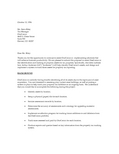
October 13, 1994Mr. Steve RileyTax ManagerOneComm4643 S. Ulster StreetSuite 500Denver, CO 80237Dear Mr. Riley:Thank you for the opportunity to continue to assist OneComm in implementing solutions that will enhance business productivity. We are pleased to submit this proposal to assist OneComm in the identification and tracking of property assets for tax purposes. Specifically, this letter outlines how Arthur Andersen LLP (“Andersen”) will help identify OneComm’s assets, and design and implement a system to track those assets for property tax reporting.BACKGROUNDOneComm is currently having trouble identifying all of its assets due to the rapid pace of asset acquisition. You are interested in assessing your current asset holdings, as well as putting a system in place to help track your property tax liabilities on an ongoing basis. We understand that you would like to accomplish the following during this project:∙Identify assets by location.∙Setup a physical (paper) file for each location.∙Itemize assessment records by location.∙Determine the accuracy of assessments and a strategy for appealing excessive assessments.∙Implement an effective program for tracking future additions to and deletions from the OneComm portfolio.∙Track taxes assessed and paid by OneComm for each location.∙Produce reports and queries based on key information from the property tax tracking system.Steve RileyOctober 13, 1994Page 2Interface with the Oracle™ Fixed Assets system.At the completion of this project you would like accurate information as to the location, value and tax liability of your current assets. You would also like an on-going system for tracking future asset additions.PROJECT SCOPE AND APPROACHThe recommended approach to this project will consist of two phases. The first phase, Property Identification and Setup, will be performed by Andersen’s property tax experts. The second phase, System Development and Population, will be performed by Andersen’s Business Systems Consulting personnel. These two phases are described below.I. Property Identification and Set-upIn order to accurately identify the current assets, on a location by location basis, Andersen personnel will require access to the raw assessment data. The task will be to identify and create a file indicating the assessors identification number and itemizing the assets for each location. Andersen personnel will work on-site at OneComm’s offices to perform this task.Upon completion of the identification process, it will then be necessary to determine what the assessment records are for each location. Andersen personnel will contact each assessment authority in order to determine what the assessment record indicates for each location. This information will then be reviewed relative to the OneComm data in order to identify significant discrepancies. Significant discrepancies will be brought to the attention of OneComm personnel in order to determine the appropriate course of action. Two options exist for correcting assessment errors:1)Many states have provisions for correction of the assessment record in the event of anerroneous assessment. If the opportunity for an appeal of the assessment exists, anappeal should be filed. This determination will have to be made on a case by casebasis.2)In other states, corrections go into effect in the next reporting period. The errorshould be corrected via an accurate declaration schedule, in the next reportingperiod.Andersen personnel will make on-site inspections and visits to the appropriate assessment offices should it become necessary for the resolution of any issues. We will confirm the need to make on-site visits to ensure out-of-pocket expenses are managed effectively.Steve RileyOctober 13, 1994Page 3II. System Development and PopulationBased upon the requirements of the property tax tracking system, and your corporate standards, we recommend that the system be developed using Microsoft Access™. Using Microsoft A ccess™as the database management system will allow us to easily customize user- input screens, queries, reports, and interfaces to the Oracle™ Fixed Assets databases. The property tax tracking system can be used by all OneComm personnel that require access to it. The basic flow of the development and implementation will be as follows:∙Design and develop the database table structures in Microsoft Access™.∙Develop an interface between Microsoft Access™ and Oracle™ Fixed Assets tables.∙Design and develop two user screens, including one screen to be used for user input of information, and a second screen to be used for uploading and downloading datafrom Oracle™.∙Develop the asset listing report.∙Provide user training for up to three people on the new system.∙Test and implement the system.∙Populate the system with the property tax data associated with OneComm’s assets.(This step is optional to OneComm. The population of the system could be done by aOneComm employee instead.)The completion of the Property Identification and Setup phase will result in a list of assets that is more complete than the current listing that is found in the Oracle™ Fixed Assets module. The effort of loading the additional assets into Oracle™’s Fixed Assets module is not included in this proposal. We will issue a separate proposal for the loading of data into Oracle™’s Fixed Assets module once the magnitude of the effort is known and if requested. This task could be completed by a OneComm employee.PROJECT SCHEDULE, TIMING, AND FEESThe Property Identification and Setup phase of the project will be managed by Tim Green. Tim will use other Andersen tax resources as needed to complete this phase of the work. The System Development and Population phase of the project will be completed by Jamie Bridges. The project schedule and fees have been broken down by phase as follows.。
咨询方法与工具资料库CHNGRDY2【精品文档】

C HANGE R EADINESS S URVEY C UT AND P ASTES AMPLE O RGANIZATIONAL C ULTURE S URVEYI NTRODUCTIONPurposeThis survey is designed to solicit your confidential input on your company/department culture, communication channels and day-to-day working environment. This survey should take about 20 minutes to complete.For this survey to be helpful and accurate in describing your organization, it is important that you answer each question as honestly as possible.ConfidentialityYour responses to this survey will be kept completely anonymous.Pleas do not sign your name. As further safeguard of your confidentiality, no one outside the Arthur Andersen project team will ever see your completed survey. Arthur Andersen will collect and compile the surveys and present the results to you and other survey participants.D IRECTIONS1. Read each item carefully2. Circle one number for each item.3. Please strive to complete your survey by , and drop it offwith one of the Project team members.C IRCLE O NE N UMBER FOR E ACH S TATEMENT.Strongly Agree Tend toAgreeHard toDecideTend toDisagreeStronglyDisagree1 Communication between departments is very open.1 2 3 4 52 Communication channels are very open here among employees.1 2 3 4 53 Communication channels are very open here among management andworkers.1 2 3 4 54 Management actively solicits input from employees before major decisionsare made.1 2 3 4 55 I can trust our management and believe what it says.1 2 3 4 56 Management seeks input from employees on major decisions.1 2 3 4 57 Most projects designed to make things better in this organization have beensuccessful.1 2 3 4 58 The number of changes that we go through here is "about right."1 2 3 4 59 This organization is very supportive of change.1 2 3 4 5OC Asahi Orientation Module 5 JA-3。
咨询方法与工具资料库01_INTRO【精品文档】

This document defines the responsibilities, activities and forms that must be completed to satisfy the Quality Assurance (QA) requirements for a Business Consulting engagement. The following content can also be found in the BC KnowledgeSpace.The following procedures and guidelines supersedes the policies and procedures established in AOP Chapter 120, “Non-Attest Engagements--General”.IntroductionThe goal of Business Consulting's engagement quality assurance process is to empower all of our professionals with the opportunity to deliver the highest quality of service to our clients. Our approach requires that all engagement team members be aware of the risks associated with engagements and the standards this Firm employs to manage these risks. While policies and procedures provide assistance in assessing and managing engagement risks we must be mindful that they are only a supplement to the sound business judgment AA professionals exercise on all engagements.Objectives The objectives of Business Consulting’s quality assurance process are to:∙Achieve and sustain consistent delivery of superior services to meet clients’ stated and real needs∙Give clients confidence that they will consistently receive superior service∙Facilitate sustained growth at accelerated pace without major problems∙Add to our knowledge capital by learning and sharing from our experiences∙Provide Firm management confidence that Business Consulting is effectively managing quality and controlling riskPerformance Measures The success of these procedures and guidelines will be measured by the following criteria:∙Clients give high satisfaction ratings∙Clients ask us to assist with additional opportunities∙Engagement personnel take ownership of quality process and comply voluntarily ∙We have “zero defects” on engagements∙Periodic practice reviews produce evidence of value and complianceAs previously noted, the scope of these process and guidelines covers the entire life cycle of an engagement which is shown in the following five phases:BC ExCEED CycleIII. Deliver Services &Monitor Progress。
咨询方法与工具资料库rfp【精品文档】
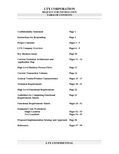
TABLE OF CONTENTS______________________________________________________________________________________________________________________________________________________Confidentiality Statement Page 1Instructions for Responding Page 2Project Calendar Pages 3 - 5LTX Company Overview Pages 6 - 9Key Business Issues Page 10Current Technical Architecture and Application Map Pages 11 - 12High Level Business Process Flows Page 13Current Transaction Volumes Page 14General Vendor/Product Characteristics Pages 15 - 17Technical Requirements Pages 18 - 21High Level Functional Requirements Page 22Guidelines for Completing Functional Requirements Matrix Page 23Functional Requirements Matrix Pages 24 - 51Estimated Costs WorksheetsSingle Location Pages 52 - 53 Two Locations Pages 54 - 55Proposed Implementation Strategy and Approach Page 56ReferencesPages 57 - 59________________________________________________________________________ LTX Corporation designs, manufactures, and markets automatic test equipment for the semiconductor industry that is used to test digital, linear and mixed signal ( a combination of digital and linear) integrated circuits (“ICs”) and discrete semiconductor components. The Company currently offers products in four broad categories: three lines of semiconductor test systems and a line of test system networking products. The three lines of test systems are: digital test systems, linear/mixed signal test systems, and discrete component test systems. LTX also sells service and applications support for its test systems. The semiconductors tested by the Company’s test systems are widely used in the computer, communications, automotive and consumer electronics industries. LTX markets its products worldwide to both manufacturers and users of digital, linear and mixed signal ICs and discrete semiconductor components. Digital ProductsLTX markets its digital test systems which include the Deltamaster and Micromaster under the Trillium name. These digital products are used to test digital ICs, in particular microprocessors and microcontrollers. These digital devices are used to operate and control nearly all electronic components. Microprocessors are found in personal computers, engineering workstations and industrial control systems and are among the most expensive semiconductor devices. Microcontrollers are used in automobiles, home appliances, cellular phones and televisions.Linear/Mixed Signal ProductsLTX offers two product lines for testing linear/mixed signal ICs, Synchro and Ninety. Linear ICs are used in almost every electronic application. The very nature of physical occurrences, such as sound, images, temperature, pressure, speed, acceleration, position and rotation, consists of continuously varying information. Linear ICs are used to amplify, filter and shape this information. Mixed signal ICs are capable of converting the signals from linear ICs into a digital format that can be processed by a computer. Mixed signal devices can also convert processed digital information into a linear form to control physical phenomena or to improve sound and images. Linear and mixed signal ICs are widely used in automobiles, computers, telephones and such home entertainment products as video cassette recorders, cameras, compact disc players and video games.Discrete ProductsThe Company’s iPTest systems are used to test discrete semiconductor components, such as diodes, small signal transistors and power transistors, as well as arrays of these components. These discrete components are used in every area of electronics. IPTest systems are also capable of accurately measuring the characteristics of transient voltage suppression components, which are widely used to protect personal computers and telecommunications products from harmful voltage spikes or surges.Networking ProductsLTX offers its EZNET hardware and software products to enable its customers to interface LTX test systems as well as com petitors’ test systems with the customer’s manufacturing, engineering or management information systems. Included in the Company/s EZNET product line is its dataVision software package, which is used by customers to collect, analyze and archive data from the testing process. These products enable LTX to provide its customers with a complete solution to their test information needs.______________________________________________________________________________________________________________________________________________________ Sales, Service and Customer SupportLTX sells, services and supports its products primarily through its worldwide sales and support organization. As of July 31, 1994, LTX maintained 22 customer support centers and 3 additional sales offices around the world. The Company considers service and support to be important to the success of its business, because of the highly technical nature of its products. Customer support activities include installation, training, field service and applications assistance. The Company’s support personnel are capable of performing all necessary maintenance of test systems sold by LTX, including routine servicing of components manufactured by third parties.CustomersThe Company’s major customers include many of the world’s leading semiconductor manufacturers such as:AT&T PhilipsHitachi SamsungIntel SGS-ThomsonMotorola Silicon SystemsNational Semiconductor SonySales to these major customers accounted for approximately 58% of net sales in fiscal 1994. No single customer accounted for 10% or more of net sales in fiscal 1994.CompetitionThe semiconductor test equipment industry is highly competitive, with many other domestic and foreign companies participating in the same markets as LTX. The Company’s major competitors in the market for digital test systems are Advantest Corporation (an affiliate of Fujitsu Limited), Schlumberger Limited and Teradyne, Inc. The Company’s principal competitor for linear/mixed signal test systems is Teradyne, Inc. The Company’s principal competitor for discrete component test systems is Tesec, Ltd.______________________________________________________________________________。
管理咨询方法和工具

管理咨询方法和工具
1.环境分析法:通过对企业内外环境进行全面、系统的分析,了解企
业所处的市场环境、行业竞争环境以及政策环境等,以便企业管理层更好
地制定战略和发展规划。
2.组织诊断法:通过对企业内部组织结构、管理层级、人员能力等因
素进行分析和评估,找出组织中存在的问题和障碍,并提出相应的改进建议,以促进组织效能的提升。
3.流程优化法:对企业内部的主要业务流程进行分析和优化,通过精
益生产、六西格玛等方法,找出流程中的瓶颈和浪费,提出改进方案,以
提高效率和质量。
4.管理培训法:通过开展各类管理培训,提升企业管理层和员工的管
理知识和技能,培养团队合作意识和领导能力,促进组织的发展。
6.绩效管理法:通过制定明确的目标、建立有效的绩效考核体系,激
励员工提升绩效,帮助企业管理层实现绩效目标,提高组织绩效和竞争力。
1.SWOT分析:对企业内外宏观环境进行全面分析,评估企业的优势、劣势、机会和威胁,为制定战略规划提供参考。
2.PESTEL分析:对企业的政治、经济、社会、技术、环境和法律等
宏观环境进行分析,帮助企业了解外部环境对业务发展的影响,为决策提
供支持。
3.5W1H分析法:通过回答“什么、为什么、谁、何时、何地、如何”等问题,对事件或问题进行详细分析,找出问题根源,并制定相应解决方案。
5.PDCA循环:通过计划、执行、检查、调整的循环过程,持续改进企业管理和业务流程,确保企业的运营效率和品质水平。
6.价值链分析:通过对企业内部各个环节的价值创造和价值传递进行详细分析,找出运营过程中存在的问题和机会,为企业提供改善建议。
咨询方法与工具资料库nytprop【精品文档】
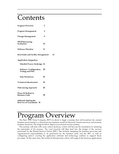
ContentsProgram Overview 2Program Management 4Change Management 6SSC/OutsourcingEvaluation 10Software Selection 12Real Estate and Facility Management 14Application IntegrationDetailed Process Redesign 16Software Configuration, 20Testing and PilotData Warehouse 24Technical Infrastructure 26Outsourcing Approach 28Phase III-Rollout toBusiness Units 30Editorial: Making theBest Use of Consultants 32Program OverviewThe New York Times Company (NYT) is about to begin a journey that will transform the current business environment to a shared services business model for financial, human resources, and revenue business functions. The diagram below depicts your shared services journey.This journey will start with some critical decisions, which will become the foundation for planning the remainder of the journey. The road traveled will then lead into the design of the services performed by the Shared Services Center (SSC). This includes designing the business processes and organizational responsibilities to be performed by the business units and the SSC, as well as configuring and/or creating the application software and technology enablers to support those processes. At the same time, the technical infrastructure which will support the business applicationswill be designed and built, and the level of service needed from a technical operations organization will be determined. Also in this phase, the site to house the shared services organization must be selected in combination with any outsourcing approaches which have been chosen. This phase of the journey will end with the conversion of the pilot organizations into the new model.The journey will continue with the transformation of the shared service from pilot operations to full production through the rollout of the new business processes and systems at each of the business unit locations. The journey ends with the successful transformation of the shared services organization into a full service operation that performs to the required service levels.Throughout the journey, program and change management functions need to be in place to ensure a smooth road and successful transition.A high-level diagram of the teams needed to complete this journey is shown on the right. It consists of three application integration teams to handle the three waves identified from your Phase I vision. In addition, there are six other teams which cross the three functional waves to:—Manage the change—Select the software—Evaluate the outsourcing alternatives—Choose the shared services site and manage the creation of the facility—Help establish the data warehouse vision—Create the technical infrastructure.Program management will ensure effective coordination of these efforts and be the link to the Program Steering Committee.The remainder of this document discusses our approach and team structure in detail for each of the areas that you requested in the proposal. On the right is a chart showing the sections you requested and how we mapped them into the sections of the document. In some cases we split them into finer detail or combined them to match our costing models.Program ManagementApproach SummaryEffective program management is critical to the success of enterprise-wide change programs. Program Management involves the management of multiple projects and initiatives that together, with one common vision or mission, make up the change program. The objectives are to:·Manage the program toward the objectives of the business case·Maintain the overall schedule for all the projects and manage project dependencies·Provide accurate and timely status reporting to management·Identify schedule and business issues early enough to allow for effective corrective action ·Provide guidance to projects to ensure success·Engage Project Champions as appropriate throughout the life cycle of the change program. Program Management encompasses all areas in the life cycle of a complex change program. It begins with a clear understanding of the business case, the "end in mind" developed during Phase I of this project, and the expected benefits to be achieved as a result of the implementation. This focus and understanding of the goals create the right framework for planning, monitoring, and tailoring the program.Key Success Factors Include:·A dedicated project champion with the support and authority to implement change·The Program Management team, a partnership of NYT and Andersen, that will bring the right mix of experience, skills, and organization knowledge to ensure appropriate "mission control" ·Effectively managing the program while balancing quality, risk, cost, and schedule·Optimizing efficiency through standard development methodologies, reporting and communications methods, and schedule tracking and management·A deliverable-oriented focus based on sound business principles that emphasize:—Beginning with the "end in mind"—Setting realistic guidelines—Measuring, reporting, and realizing benefits.Our initial approach will be to structure the Program Management team to focus on two important areas: the initial implementation planning effort and building of the Program Management "office." The initial planning effort will include developing an implementation plan with clear deliverables, accountabilities, dependencies, checkpoints and milestones. It will involve detailed planning by the project segment team leaders.Program Management provides the structure and guidance from the beginning. Building the Program Management "office" will:·Establish the program tracking environment and procedures:—Determine and implement project management tools—Develop project tracking procedures and rollout to project teams—Implement program status reporting process—Schedule Steering Committee meetings—Establish issue tracking and resolution process.·Develop standards and tools to facilitate team communication—Determine standards for deliverables—Define and implement support and productivity tools (Project LAN, E-mail, voicemail, contact lists, standards for word processing, spreadsheet, graphics, CASE tools)·Establish program financials and reporting—Create the model to appropriately track and report against the business case—Develop and roll out program accounting "system"·Define and implement a quality management program—Determine quality objectives and goals—Determine program expectations and issues—Develop project metrics and key success factors—Determine reward and recognition program for the effort—Determine quality assurance approach and schedule·Assist in the program-related procurement processes—Software vendor negotiations—Sourcing arrangements—Vendor relations.On a continual basis, Program Management will:·Vigorously manage multiple project teams against their plans·Manage the business case economics throughout the program life cycle·Perform project team human resources management including staffing, recognition and rewards and performance evaluations·Assist in Procurement and Vendor/Contract Management·Track deliverables and manage the program library·Work hand-in-hand to help the Change Management team to successfully manage the organization change·Prepare for and run the Steering Committee Meetings.Key Factors to Consider·Allocating enough time during the design and development of the program management organization to develop a robust communication infrastructure that allows and supports clear levels of communication, responsibility, and accountability·Empowering the program management organization with the authority to effect changes across the projects·Allocating the personnel resources to the program management team that will allow them to monitor and manage the programs in a proactive manner.Assumptions·The Program Management organization will be composed of both NYT and Andersen representation·Program Management will be set up immediately. Logistical decisions can be resolved immediately.。
咨询方法与工具资料库combpil【精品文档】
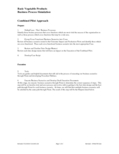
Combined Pilot ApproachPrepare1. DefineCases - Vital Business ProcessesIdentify those busines processes that cross functions which are most vital the success of the organization as well as those process which cross functions that may be a risk area.2. Group Cross Functional Business Scenarios into CasesReview all business scenarios tested in the Customer Impact and Production Pilots and identify those which are cross functional. Place each cross functional business scenario into the most appropriate Case.3. Review and Finalize Data Design Memos)Review each data design memo that will have an impact on the Execution of the Combined Pilot.4. Develop Case ScriptExecution5. ToolsTools are guides and helpful documents that will aid in the process of executing our business scenarios through Prism and developing Procedure Outlines.6. Execute Business Scenarios and Develop Draft Execution DocumentsAt this stage, we execute business scenarios through Prism to determine the correct sequence of steps. This step will be an iterative trial and error process and evolve with us getting to the best data design and the best path through Prism for each business scenario. At times, we will find that multiple business scenarios will be satisfied by the same path through Prism. The result of this step will be the Outputs listed below.Conclude/Outputs7. Data Design Affirmed/Create Data Design MemosPilot data will need to be finalized. Final versions of Data Design Memos must be placed in the directory mentioned above. Actual data (file printouts, reports, etc.) used to test business scenarios must be attached to the Procedure Scripts used to test business scenarios and placed into our working papers.8. Completed- Outline ProceduresA set of Procedure Outlines will evolve to completion that cover all business scenarios introduced into Prism. There will not necessarily be a one to one relationship between the incoming business scenarios and the procedure outlines we create. As mentioned in Step 6, multiple business scenarios may follow the same path through Prism, and, in turn, result in one encompassing Procedure Outline. An example of a Procedure Outline is currently being developed.9. EnhancementsInformation Systems team will publish.10. Interface DescriptionsInformation Systems team will publish.11. Implementation Plan - EstimatingTo be published.12. Implementation PlanTo be published.Business Scenario DocumentDefinition - A document listing of business scenarios for Modesto, King City and Puregar that account for events occurring within a process area.Place the Business Scenario documents in M:\PHASE1\(PROJECT TEAM)\BUSSCEN\(FILENAME). FILENAME will be as follows:Process Area 4 digit Business Process CodeExample OP 2010Operations # for Schedule PackagingFields on Document:Business Scenario # - This number is unique to the business scenario. The numbering convention is as follows:Process Area 4 digit Business Process Code Business Scenario #Example OP 2010 01Operations # for Schedule Packaging 1st Business Scenario of 10M/K/B/P - This field indicates whether a business scenario is applicable for Modesto, King City,Both(Modesto and King City), and/or Puregar.Description - A textual description of the business scenario.Tested - Columns are listed for Modesto(M), King City(K), Both(Modesto and King City), and Puregar(P) to reference a successful test.Procedure Outline - This is the number of the Procedure Outline(s) used to execute the business scenario through Prism.。
- 1、下载文档前请自行甄别文档内容的完整性,平台不提供额外的编辑、内容补充、找答案等附加服务。
- 2、"仅部分预览"的文档,不可在线预览部分如存在完整性等问题,可反馈申请退款(可完整预览的文档不适用该条件!)。
- 3、如文档侵犯您的权益,请联系客服反馈,我们会尽快为您处理(人工客服工作时间:9:00-18:30)。
Background and ObjectivesThe System and its physicians recognize that the market for health care services is in flux in the Zephyrhills/Tampa area. Whether health care reform moves forward at the speed of a flaming arrow or as slowly as a hesitant turtle, purchasers of health care are initiating change. Note:Our understanding is that the Medical Center and its physicians’ objectives are to identify the needs of the market and to develop the appropriate integration strategy to meet these needs. To accomplish this goal, the Medical Center and physicians should share common values and a clear direction that will move the two on a path toward partnership.Hospital-Physician Integration—Arthur Andersen’s ApproachThe health care reform initiative, coupled with the evolution of managed care, has created an impetus for the working relationships between hospitals and physicians to achieve a new level of cooperation. In order to rise to the challenges that lie ahead, physicians and hospitals are finding it advantageous, if not essential, to coordinate their efforts so that they may assemble an integrated set of services to effectively compete in the new environment.Physician-hospital integration offers a strategy for physicians and hospitals to survive as players in all markets — fee for service, prospective payment managed care and nonmanaged care. The conceptualization of physician-hospital integration as a series of models which can be arranged along a continuum can be extremely helpful in developing a foundation of understanding in this area. The risk of this approach, however, is that it suggests the erroneous notion that integration is an end itself. In fact, physician-hospital integration is a process. The structure or form of integration should be developed based on the forces in the marketplace in which it is evolving. A complete description of our integration philosophy is included in Attachment I.We believe that successful implementation of any strategy will require a comprehensive understanding of the individual environments and the ability to recognize the interdependence of physicians and hospitals. The willingness to develop an open, trustworthy relationship with each other, the recognition by the leadership of the combined organizations that the process must represent a win-win situation, and the development of incentives which properly motivate both parties hold the keys to success.Although the common interests of physicians and hospitals will facilitate this new alliance, the competing values of the two groups could serve as a critical deterrent. These differing perspectives must be well understood and accounted for if integration efforts are to be successful.As we move from a fee-for-service, production-driven, specialist-dominated environment to a capitated, conservation driven, primary care-directed system, relationships between physicians and hospitals will be more challenging than ever before. As hospitals begin to propose strategies to position themselves in the new environment, they are likely to be criticized by specialists for moving too quickly and by primary care physicians for moving too slowly. Making the transition from the past to the future, while harmonizing these competing interests, will prove to be a difficult balancing act.Hospital-Physician Integration—Arthur Andersen's Approach (Cont.)Our Work Is Characterized by Its Facilitation of a Strategic Process;i.e.; Form Follows FunctionHospital-physician integration around the country is taking a variety of forms. There is no single direction or central theme; in many cases, strategic direction is lacking. This is not to say that integration is not occurring or that the process is not under discussion. Clearly, integration is being both discussed and implemented.Arthur Andersen has significant experience and resources dedicated to the development of integrated health care systems. We have demonstrated many times that our approach is sensitive to the political environment and the need to implement significant change. More importantly, Arthur Andersen is one of only a handful of firms that have all the required resources to successfully develop and implement an integration strategy. These resources include the following:In addition, our understanding of the Atlanta market, as demonstrated by our managed care study, puts Arthur Andersen in a leadership position among all the firms providing integration services.。
